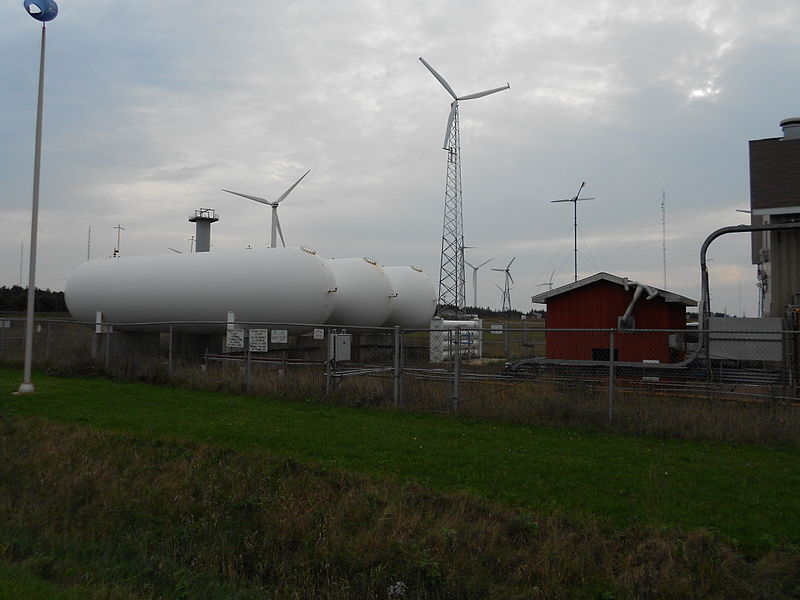Will wind power support a hydrogen economy?

Hydrogen, an energy carrier, exists abundantly in nature. However, it is always married to other elements in the form of water, hydrocarbons and other organic compounds. For use as an industrial gas or energy carrier, people need hydrogen unattached to other elements.
In 1783, Jacques Charles first used hydrogen as “energy” to lift his balloon flight. Since then, hydrogen has been used in various daily applications. Hydrogen is mainly produced from fossil fuels such as methane by the steam reforming method. Although this process has a low cost, it emits a large amount of greenhouse gas pollution.
In 1783, Jacques Charles first used hydrogen as “energy” to lift his balloon flight. Since then, hydrogen has been used in various daily applications. Hydrogen is mainly produced from fossil fuels such as methane by the steam reforming method. Although this process has a low cost, it emits a large amount of greenhouse gas pollution.
Hydrogen produced from water by renewable energy:
Fortunately, alternative methods exist to produce hydrogen, such as electrical water electrolysis, photoelectrochemical water electrolysis and biological processes. So far, electrical water electrolysis has the most developed technologies and commercial applications.
Electrical water electrolysis splits the water into hydrogen and oxygen under the catalysis of an electric current, which can be sourced from wind, photovoltaic, hydroelectric, geothermal and nuclear. Depending on the electrolyte material, four different types of electrolyzers exist:
- Brine electrolyzer: hydrogen produced from sodium chloride water solution
- Alkaline electrolyzer: hydrogen produced from liquid alkaline solution of sodium or potassium
- Proton exchange membrane (PEM) electrolyzer and solid oxide (SO) electrolyzer: both systems generate hydrogen and oxygen from water
Hydrogen and wind:
Of all the renewable electricity options, wind has the highest potential to produce sustainable hydrogen because of its economic competitiveness. In term of electrolyzers, the PEM system enjoys widest use. A PEM electrolyzer contains a solid polymer electrolyte. At the anode, water will convert to oxygen and positively charged hydrogen ions. The hydrogen ions move across the PEM to the cathode. At the cathode, hydrogen ions combine with electrons, which flow to the external circuit from the anode, to form atomic hydrogen.
PEM electrolyzers were first developed in the 1960s by General Electric to overcome the drawbacks of alkaline electrolyzers, such as low partial load range, limited current density and low operating pressure. PEM electrolyzers thus reduce the operational costs, especially when coupled with a very dynamic energy source like wind. However, recent research suggests a state of the art alkaline water electrolysis may have better efficiency than PEM. The SO electrolyzer also shows promise, but requires further development.
Of all the renewable electricity options, wind has the highest potential to produce sustainable hydrogen because of its economic competitiveness. In term of electrolyzers, the PEM system enjoys widest use. A PEM electrolyzer contains a solid polymer electrolyte. At the anode, water will convert to oxygen and positively charged hydrogen ions. The hydrogen ions move across the PEM to the cathode. At the cathode, hydrogen ions combine with electrons, which flow to the external circuit from the anode, to form atomic hydrogen.
PEM electrolyzers were first developed in the 1960s by General Electric to overcome the drawbacks of alkaline electrolyzers, such as low partial load range, limited current density and low operating pressure. PEM electrolyzers thus reduce the operational costs, especially when coupled with a very dynamic energy source like wind. However, recent research suggests a state of the art alkaline water electrolysis may have better efficiency than PEM. The SO electrolyzer also shows promise, but requires further development.
Wind-to-hydrogen projects in various countries:
A number of projects already exist around the world, or are being built:
Netherlands: The Netherlands plans to build a hydrogen-generating wind turbine in the Wieringermeer area at the start of 2019. The project, named “Duwaal”, exists as a partnership between HYGRO, a sustainable hydrogen supplier, Largerwey, a wind turbine manufacturer, and the Energy Research Centre of Netherlands (ECN). Different from other projects utilizing hydrogen produced from wind energy, the Duwaal project integrates a wind turbine with an electrolyser to produce “sustainable hydrogen” directly. The produced hydrogen will go to at least five hydrogen refueling stations to serve 100 hydrogen powered trucks.
Japan: A project designed to test a sustainable hydrogen supply chain from wind operates at Tokyo Bay in Yokohama and Kawasaki. Electricity generated from the Yokohama City Wind Power Plant electrolyzes water to produce hydrogen. The hydrogen powers fuel cell forklifts at four locations, including a factory, a vegetable and fruit market and two warehouses. The project has many partners, including the Kanagawa Prefectural Government and the municipal city governments of Yokohama and Kawasaki, Iwatani Corporation, Toshiba Corporation, Toyota Motor Corporation, Toyota Industries Corporation, Toyota Turbine and Systems, Inc. and Japan Environment Systems Co., Ltd.
USA: A project called “Wind to Hydrogen” exists as a cooperation between Xcel Energy and the National Renewable Energy Laboratory (NREL). This project aims to improve the sustainability of hydrogen produced from wind so that it can compete with traditional energy sources. At the National Wind Technology Center near Boulder (Colorado), where the project sits, electricity from two wind turbines electrolyzes water to produce hydrogen. Generated hydrogen is compressed and stored for later use, either at a hydrogen fueling station or by converting it back to electricity and integrating it into the power grid.
Other countries also have projects, including Denmark with HyBalance, Scotland with Surf ’n’ Turf, Germany with h2herten, and several others.
For now, wind-to-hydrogen remains a niche technology in the ever expanding renewable energy landscape. However, as more projects like the above come online, and if hydrogen infrastructure grows, this approach may join more established sources of renewable energy in powering our future.


Comments
Post a Comment